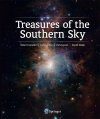Art / Photobook
Out of Print
By: Robert Gendler(Author), Lars Lindberg Christensen(Author), David Malin(Author)
220 pages, 148 colour photos
![Treasures of the Southern Sky Treasures of the Southern Sky]()
Click to have a closer look
About this book
Contents
Biography
Related titles
About this book
This coffee-table book depicts famous features of the southern sky, such as the Magellanic Clouds and the Tarantula Nebula, as well as the brilliant star cluster Pismis 24, the beautiful NGC 1532-1 pair of interacting galaxies and the radiant Toby Jug Nebula.
Contents
- Preface
- Introduction
- The Discovery of the Southern Sky
- The Southern Saummer
- The Southern Fall
- The Southern Winter
- The Southern Spring
- Index
Customer Reviews
Biography
Robert Gendler is an amateur astrophotographer whose astrophotography has earned him international acclaim. He was featured in the PBS documentary Seeing in the Dark by Timothy Ferris, who called Gendler "one of the greatest astrophotographers in all of history." Robert is known among fellow astrophotographers as a pioneer always exploring ways to push the available technology beyond its limits. He has published two books on astrophotography. The first A Year in the Life of the Universe (Voyageur Press, 2006) was published in four languages (English, Spanish, Polish, and Greek). His latest astrophotography book Capturing the Stars: Astrophotography by the Masters (2009) highlights the work of the most accomplished astronomical imagers in the world. Gendler recieved the Hubble Prize for contributions to astrophotography at the Advanced Imaging Conference at San Jose, California in 2007. Robert lives in Avon, Connecticut with his wife and two children. He work can be viewed at www.robgendlerastropics.com
Lars Lindberg Christensen is an award-winning science communication specialist who heads the European Southern Observatory education and Public Outreach Department, where he is responsible for public outreach and education for the VLT, La Silla, for ESO's part of ALMA, E-ELT and ESA's part of the Hubble Space Telescope. He obtained his Master's Degree in physics and astronomy from the University of Copenhagen, Denmark and has more than 100 publications to his credit, most of them in popular science communication and its theory. He has written several books on popular science and science communication that have appeared in Finnish, Portuguese, Danish, German, Korean, Japanese and Chinese. Lars is Press Officer for the International Astronomical Union (IAU) and founder of the ESA/ESO/NASA Photoshop FITS Liberator project, manager of the IAU International Year of Astronomy 2009 Secretariat and the Executive producer and director of two astronomy documentaries.
David Malin has been involved in scientific imaging almost all of his working life. In the 1960's, he worked for a large international chemical company in the north of England, where he founded and ran a laboratory that used physical methods such as microscopy and X-ray diffraction techniques to solve problems in pure and applied chemistry. The enabling technology for may of those techniques at that time was photography. In 1975, he was recruited as photographic scientist for the newly commissioned Anglo-Australian Telescope (AAT) in Australia, and turned his attention to larger and more distant things. At the AAT he developed several new photographic that led to some significant astronomical discoveries. The same processes also allowed the creation of some of the first 3-color images of astronomical objects in 1978, and these photographs have been widely published and used by David Malin and others to explore and explain the astonishing beauty of the objects of the night sky. The additive 3-color process is now universally used by both amateur and professional astronomers alike. Only the detector has changed. David is now retired but still actively involved with the AAO. He lives in Sydney with his wife Phillipa, where they enjoy their three children and numerous grandchildren.
Art / Photobook
Out of Print
By: Robert Gendler(Author), Lars Lindberg Christensen(Author), David Malin(Author)
220 pages, 148 colour photos

































